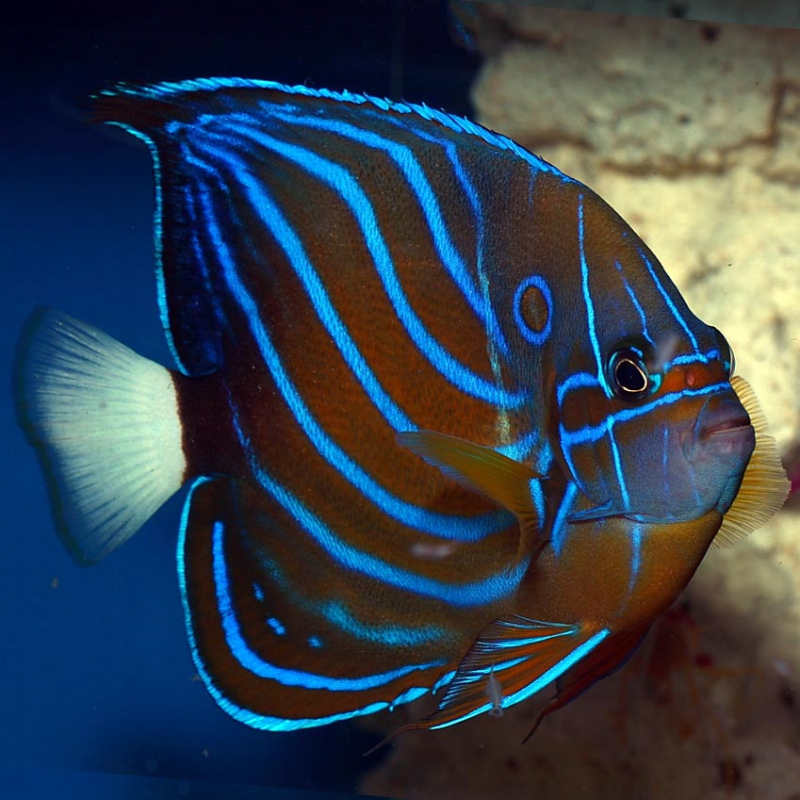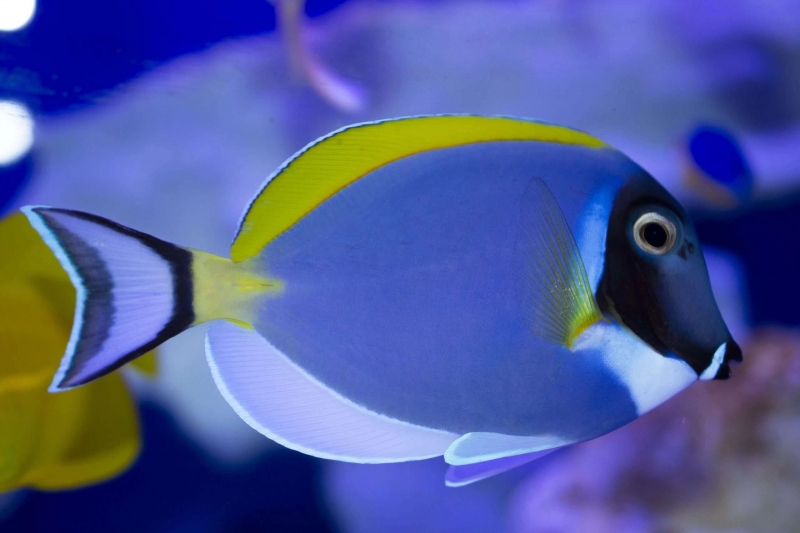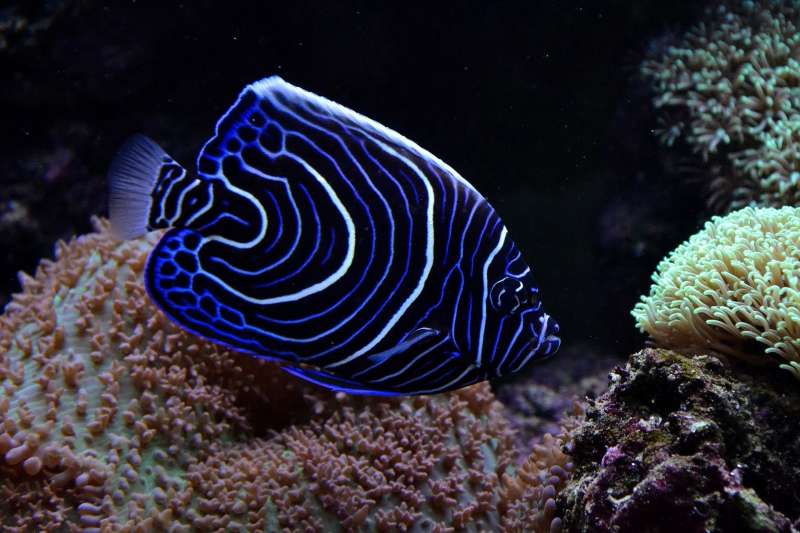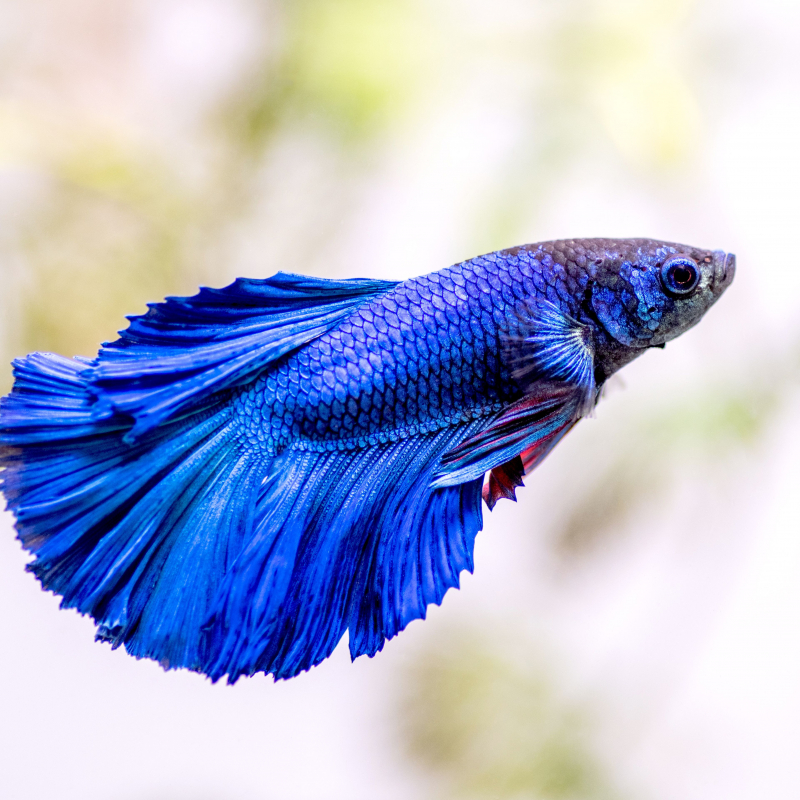Top 10 Spectacular Blue Coloured Fish
Fish colors serve a variety of purposes, including sex identification and species recognition. Juveniles occasionally have unique color patterns that assist ... read more...distinguish them from their predators or sex rivals. Colors can also be used to blend in with the surroundings and provide cover from predators. Bluefish are unique and special-looking since blue is found in nature much more rarely than other colors. Here is a list of spectacular blue-colored fish in the world, let's find out!
-
The Bluering Angelfish (Pomacanthus annularis), also known as the Annularis Angelfish and the Blue King Angelfish, is a species of marine ray-finned fish, a marine angelfish belonging to the family Pomacanthidae. It belongs to the Pomacanthus genus, which includes huge marine angelfish. The Indo-West Pacific seas, which stretch from East Africa, through Indonesia and New Guinea, through New Caledonia, north to southern Japan, are home to the bluering angelfish.
Adult bluering angelfish are primarily yellow in color, with distinct blue arcing lines and a blue circle-shaped mark above the operculum on the body. They often have an extended dorsal fin tip, and their caudal fin is white with a yellow border. They also have two blue stripes on their faces, one of which passes through the eye and the other of which is located right next to it. The juveniles have a bluish-black overall color and tiny, curving lines on their bodies that range in color from white to blue. The anal fin has three spines and 20 soft rays, compared to the dorsal fin's 13 spines and 20–21 soft rays. The longest overall length of this species is 45 cm (18 inches).

Abyss Aquatics 
Kidadl -
The Ribbon Eel (Rhinomuraena quaesita), also known as the leaf-nosed moray eel or bernis eel, is a species of moray eel, the only member of the genus Rhinomuraena. The Indo-Pacific region, which stretches from East Africa to southern Japan, Australia, and French Polynesia, is home to lagoons and reefs where ribbon eels can be found. The heads and anterior bodies of this species, which are widely spread and regularly spotted by divers in Indonesian seas, protrude from cracks in sand and rubble environments from extremely shallow depths to around 60 meters. Despite being typically classified as a member of the moray eel family Muraenidae, it possesses some unique characteristics that have led some to classify it as a member of the Rhinomuraenidae.
The ribbon eel's long, slender body and prominent dorsal fins resemble those of a fabled Chinese dragon. The enlarged anterior nostrils of the ribbon eel make it easy to identify it. They are well recognized for their distinctive jaws, which frequently open quite widely in response to an approaching diver. It is usually believed to be a protandric hermaphrodite (initially male, then changing sex to female), however, this has not yet been verified, based on observable color changes. There are no known examples of color change associated with sex transition in any other moray eel species. In adult males, the black is replaced by blue, while in adult females, the color is totally yellow or yellow with some blue to it. The supposed youngsters and subadults are jet black with a yellow dorsal fin.

VPAS 
VPAS -
Regal Tang (Paracanthurus hepatus) is a species of Indo-Pacific surgeonfish. A popular fish in marine aquaria, it is the only member of the genus Paracanthurus. The Indo-Pacific is home to the Regal Tang. The Great Barrier Reef of Australia, the Philippines, Indonesia, Japan, New Caledonia, Samoa, East Africa, and Sri Lanka all have them as do the reefs. One of the most prevalent and well-liked marine aquarium fish in the world is the regal tang. They reside in pairs or compact communities of eight to fourteen people. On the seaweed side of coral reefs, you can also find them next to cauliflower corals.
They feature a black "palette" pattern, a yellow tail, and a royal blue body. In the western and central Indian Ocean, the bottom body is yellow. It expands to 30 cm (12 inches). Males are typically larger than females and weigh about 600 g (21 oz) on average as adults. This fish has a circular body shape, a pointed, pancake-like nose, thin scales, and a flat, pancake-like appearance. The regal tang has three anal spines, 24–26 anal soft yellow rays, 26–28 dorsal soft rays, and nine dorsal spines.

Wikipedia 
Live Science -
Powder Blue Tang (Acanthurus leucosternon) is a marine tropical fish belonging to the surgeonfish family, Acanthuridae. Tropical waters of the Indian Ocean are where they can be found. The species lives in shallow, clean coastal waters that are almost always surrounded by a reef. It favors places on seaward slopes and reefs with flat tops. The powder blue tang, like most fish in the family Acanthuridae, is herbivorous, eating mostly benthic algae. This animal has a diurnal activity. It is solitary, territorial, and aggressive with other surgeonfish.
The fish can grow to a maximum length of 23 cm (9 inches). The body is squeezed laterally and has an oval shape. Acanthurus leucosternon swims with its pectoral fins, just like other surgeonfish. The caudal fin is shaped like a crescent. The base of the fish's tail is home to an elevated section of the spine known as the "surgeon's scalpel". The teeth are small and sharp to fit into the microscopic spaces of food, and the mouth is short and pointed like a beak. Its sides are blue, its dorsal fin and caudal fin base are yellow, its head is black, and its mouth, throat region, anal fin, and pelvic fin are all white. The transparent pectoral fins have yellow reflections.

House of Fins 
Wikiwand -
The Yellowbar Angelfish (Pomacanthus maculosus) or half-moon angelfish, yellow-marked angelfish, yellowband angelfish, or yellow-blotched angelfish, is a species of marine ray-finned fish, a marine angelfish belonging to the family Pomacanthidae. It can be found in the eastern Mediterranean Sea and, more recently, the western Indian Ocean. Although other invertebrates may be consumed incidentally, sponges and tunicates make up the majority of their diet.
Pomacanthus maculosus has a small mouth filled with tiny bristle-like teeth and a deep, compressed body. At the preoperculum angle, they have a clear spine. Adults have filaments that extend past the caudal fin from the soft-rayed regions of the dorsal and anal fins. Adult scales appear to be mostly blue because of the brownish blue backdrop and blue margins on each scale. Near the center of the flanks, there is an uneven yellow band with dark blue, vertically elongated dots toward the head. On a light yellow backdrop, the caudal fin displays blue lines that are wavelike. The youngsters have three wider white lines and numerous arced, vertical blue lines markings on their mostly black bodies. Only the rear third of the caudal fin is yellow.

Pixels 
Pixels -
Yellowtail Damselfish (Chrysiptera parasema), also known as a yellowtail blue damsel, goldtail demoiselle, and other variations, is a popular saltwater aquarium fish from the Indo-Pacific. It was described by Fowler in 1918. These animals typically stay at a depth of between 3-52 feet (1-16 m) and prefer densely crowded coral groupings in protected lagoons and inshore reefs. In captivity, it shows a preference for spirulina, flake foods, and Mysis shrimps. However, they tend to go after most fish foods, whether frozen, freeze-dried or live. These fish tend to feed towards the bottom of the tank.
The yellowtail damselfish has a recognizable yellow caudal fin (tail fin). Particularly in Papua New Guinea species, the golden color may reach the anal and dorsal fins' backs. Additionally, these fish may have yellow pectoral or pelvic fins. However, Yellowtail damselfishes never have yellow on their backs or bellies. The fish may be an Azure demoiselle if it has a yellow belly, while a Blue Devil damsel can have yellow spots on its snout or chin.
Monaco Nature Encyclopedia 
TFH Magazine -
A type of marine angelfish is called the Emperor Angelfish (Pomacanthus imperator). It is a fish that lives near reefs and is found in the Red Sea, the Indian and Pacific Oceans, Hawaii, and the Austral Islands. This species typically has steady numbers and is not endangered in any significant ways. Because of its distinctive, vivid pattern of colors, it is a favorite among photographers, artists, and aquarists.
The emperor angelfish exhibits a clear distinction between its juvenile and adult forms. The bodies of the juveniles are dark blue with concentric curving lines that alternate between pale blue and white, the smallest of which are placed posteriorly and are totally encased within one another. At the front, these lines are vertical. The caudal fin is transparent, whereas the dorsal fin has a white edge around it. The adults have a light blue face with a dark blue mask covering the eyes, horizontal blue and yellow stripes, and a yellow caudal fin. Above the pectoral fins, there is a blackish band, the top of which is above the level of the upper orbit. The front margin of this band is bright blue and the rear margin is a thin yellow line. The anal fin has a dark blue background with light blue horizontal stripes.

Pinterest 
Snorkeling Thailand -
Cichlids in the genus Symphysodon also referred to as Discus, are indigenous to the Amazon river basin in South America. Discus are well-liked as freshwater aquarium fish due to their unusual shape, behavior, and vibrant colors and patterns, and their aquaculture is a significant sector in many Asian nations. They are occasionally known as pompadour fish.
All Symphysodon species have a laterally compressed body form, just like cichlids from the genus Pterophyllum (angelfish). But unlike Pterophyllum, Symphysodon lacks extensive finnage, giving it a more rounded appearance. They got their popular name "discus" because of their body form. The fish frequently has patterns on its flanks in the colors green, red, brown, and blue. Aquarists have selectively bred some of the more vividly marked forms, which are extinct in the wild. For this fish, there isn't any obvious sexual dimorphism, but males can grow to be bigger than females.

Pinterest 
Aquarium Central -
The Cherubfish (Centropyge argi), also known as the pygmy angelfish, is a species of marine ray-finned fish, a marine angelfish belonging to the family Pomacanthidae. The western Atlantic Ocean is where you can find cherub fish. It can be found off Bermuda, off North Carolina, in the Caribbean Sea and the Gulf of Mexico, off Bermuda, and as far east as French Guiana.
The body of the cherub fish is round, deep, and laterally compressed. It also has a small mouth and a short, blunt snout. At the angle of the preoperculum, there is a long, sturdy spine with a serrated vertical edge. The head and breast are orange-yellow, and the body is a deep blue color with a thin blue eye ring and a little dark blue bump at the back of the mouth. The other fins are dark blue with light blue borders, whereas the pectoral fins are pale yellowish. The anal fin has 3 spines and 17 soft rays, compared to the dorsal fin's 14–15 spines and 15–16 soft rays. The longest overall length of this species is 8 centimeters (3.1 inches).

Wikipedia 
Alyssa's Seahorse Savvy -
Southeast Asia, specifically Cambodia, Laos, Myanmar, Malaysia, Indonesia, Thailand, and Vietnam, is home to the freshwater fish known as the Betta (Siamese fighting fish). Due to their widespread appeal as pets and their comparatively low maintenance requirements, Betta splendens are among the most widely kept aquarium fish in the world. There are 73 species in the genus Betta, but only one is given the name "betta". The Siamese fighting fish is not only well-known internationally, but it is also Thailand's national aquatic animal, which continues to be the country's principal source of betta breeding and export. The IUCN has classed Betta as "vulnerable" due to rising pollution and habitat destruction, despite the fact that they are often used as pets.
Typically, B. splendens reaches a length of 6–8 cm (2.4–3.1 inches). Although B. splendens aquarium specimens are well recognized for their vivid colors and huge, flowing fins, wild fish only display vibrant colors when they are agitated; their usual coloring is often blue, green, brown, and grey. Siamese fighting fish have been intentionally developed in captivity to exhibit a brilliant variety of colors and tail patterns.

The Spruce Pets 
Pinterest































